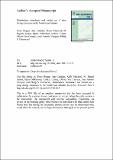Files in this item
Distribution, abundance and habitat use of deep diving cetaceans in the North-East Atlantic
Item metadata
| dc.contributor.author | Rogan, Emer | |
| dc.contributor.author | Cañadas, Ana | |
| dc.contributor.author | Macleod, Kelly | |
| dc.contributor.author | Santos, M. Begoña | |
| dc.contributor.author | Mikkelsen, Bjarni | |
| dc.contributor.author | Uriarte, Ainhize | |
| dc.contributor.author | Van Canneyt, Olivier | |
| dc.contributor.author | Antonio Vázquez, José | |
| dc.contributor.author | Hammond, Philip S. | |
| dc.date.accessioned | 2018-10-06T23:47:13Z | |
| dc.date.available | 2018-10-06T23:47:13Z | |
| dc.date.issued | 2017-07 | |
| dc.identifier | 249667909 | |
| dc.identifier | 886b1540-2b60-4620-9a54-da4f41e70c76 | |
| dc.identifier | 85018436968 | |
| dc.identifier | 000405251400002 | |
| dc.identifier.citation | Rogan , E , Cañadas , A , Macleod , K , Santos , M B , Mikkelsen , B , Uriarte , A , Van Canneyt , O , Antonio Vázquez , J & Hammond , P S 2017 , ' Distribution, abundance and habitat use of deep diving cetaceans in the North-East Atlantic ' , Deep Sea Research Part II: Topical Studies in Oceanography , vol. 141 , pp. 8-19 . https://doi.org/10.1016/j.dsr2.2017.03.015 | en |
| dc.identifier.issn | 0967-0645 | |
| dc.identifier.other | RIS: urn:EA2A26932A09BAF51C5924B846313C58 | |
| dc.identifier.other | ORCID: /0000-0002-2381-8302/work/47531616 | |
| dc.identifier.uri | https://hdl.handle.net/10023/16159 | |
| dc.description | CODA was funded with contributions from UK Department for Environment, Food & Rural Affairs; UK Department for Trade & Industry; Irish Department of the Environment, Heritage & Local Government; Irish Bord Iascaigh Mhara and the Spanish Ministry of the Environment and Rural and Marine Affairs via the Spanish Cetacean Society. SCANS-II was funded by the EU LIFE Nature programme under Project LIFE04NAT/GB/000245 and by the governments of all range states: Belgium, Denmark, France, Germany, Ireland, Netherlands, Norway, Poland, Portugal, Spain, Sweden and UK. The survey in the Faroese block of T-NASS was funded by the Faroese government. | en |
| dc.description.abstract | In spite of their oceanic habitat, deep diving cetacean species have been found to be affected by anthropogenic activities, with potential population impacts of high intensity sounds generated by naval research and oil prospecting receiving the most attention. Improving the knowledge of the distribution and abundance of this poorly known group is an essential prerequisite to inform mitigation strategies seeking to minimize their spatial and temporal overlap with human activities. We provide for the first time abundance estimates for five deep diving cetacean species (sperm whale, long-finned pilot whale, northern bottlenose whale, Cuvier's beaked whale and Sowerby's beaked whale) using data from three dedicated cetacean sighting surveys that covered the oceanic and shelf waters of the North-East Atlantic. Density surface modelling was used to obtain model-based estimates of abundance and to explore the physical and biological characteristics of the habitat used by these species. Distribution of all species was found to be significantly related to depth, distance from the 2000m depth contour, the contour index (a measure of variability in the seabed) and sea surface temperature. Predicted distribution maps also suggest that there is little spatial overlap between these species. Our results represent the best abundance estimates for deep-diving whales in the North-East Atlantic, predict areas of high density during summer and constitute important baseline information to guide future risk assessments of human activities on these species, evaluate potential spatial and temporal trends and inform EU Directives and future conservation efforts. | |
| dc.format.extent | 1190536 | |
| dc.language.iso | eng | |
| dc.relation.ispartof | Deep Sea Research Part II: Topical Studies in Oceanography | en |
| dc.subject | Design-based abundance | en |
| dc.subject | Model-based abundance | en |
| dc.subject | Beaked whales | en |
| dc.subject | Sperm whales | en |
| dc.subject | Pilot whales | en |
| dc.subject | Distribution | en |
| dc.subject | Deep divers | en |
| dc.subject | Habitat models | en |
| dc.subject | QH301 Biology | en |
| dc.subject | GC Oceanography | en |
| dc.subject | DAS | en |
| dc.subject.lcc | QH301 | en |
| dc.subject.lcc | GC | en |
| dc.title | Distribution, abundance and habitat use of deep diving cetaceans in the North-East Atlantic | en |
| dc.type | Journal article | en |
| dc.contributor.sponsor | European Commission | en |
| dc.contributor.institution | University of St Andrews. Scottish Oceans Institute | en |
| dc.contributor.institution | University of St Andrews. Sea Mammal Research Unit | en |
| dc.contributor.institution | University of St Andrews. School of Biology | en |
| dc.contributor.institution | University of St Andrews. Marine Alliance for Science & Technology Scotland | en |
| dc.contributor.institution | University of St Andrews. Centre for Research into Ecological & Environmental Modelling | en |
| dc.identifier.doi | https://doi.org/10.1016/j.dsr2.2017.03.015 | |
| dc.description.status | Peer reviewed | en |
| dc.date.embargoedUntil | 2018-10-07 | |
| dc.identifier.url | http://www.sciencedirect.com/science/article/pii/S0967064517300917#appd002 | en |
| dc.identifier.grantnumber | SCANS LIFE | en |
This item appears in the following Collection(s)
Items in the St Andrews Research Repository are protected by copyright, with all rights reserved, unless otherwise indicated.

